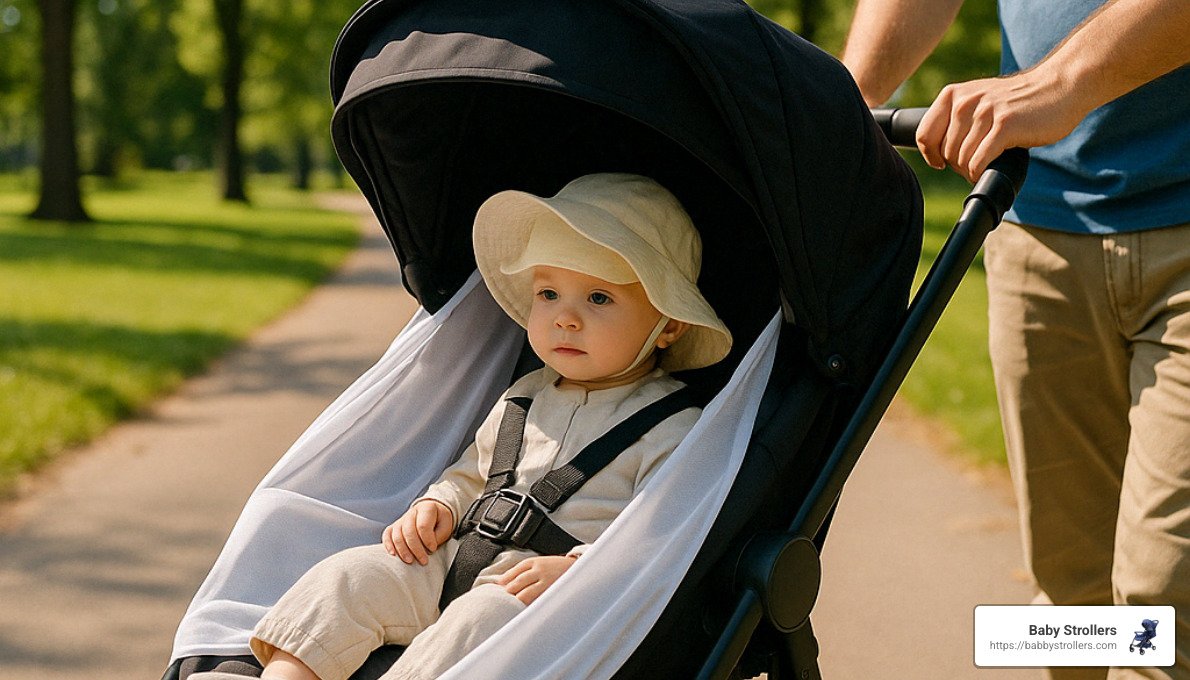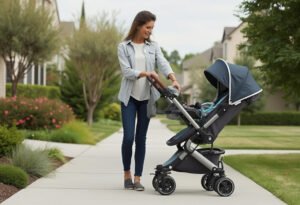How to Protect Baby from Sun in Stroller: Top Tips 2025
Protecting Your Little One From Harmful UV Rays
How to protect baby from sun in stroller is crucial for every parent, as infants have delicate skin that’s highly susceptible to UV damage. Just one sunburn in infancy increases the risk of developing skin cancer by 50%, while five instances can raise that risk to 80%.
For those seeking quick guidance, here are the essential ways to protect your baby from sun in a stroller:
- Use a stroller with a large UPF 50+ canopy that allows airflow
- Never cover with blankets – this creates a dangerous greenhouse effect
- Use air-permeable mesh covers that block 80-99% of UV rays
- Dress baby in lightweight, breathable clothing covering arms and legs
- Apply mineral-based sunscreen only if baby is over 6 months
- Avoid outings during peak sun hours (10 AM – 4 PM)
- Check baby frequently for signs of overheating
- Use a stroller fan to improve air circulation
When a Swedish pediatrician tested stroller temperatures, he found that an uncovered stroller reached 71°F in the sun, but with a thin cover added, the temperature soared to 93°F within just 30 minutes and nearly 99°F after an hour. This highlights why proper sun protection is not just about preventing sunburn, but also avoiding dangerous overheating.
I’m James Mark, a stroller safety expert with over 10 years of experience researching how to protect baby from sun in stroller conditions across various climates and stroller designs. My work has focused on finding the balance between effective UV protection and proper ventilation to keep babies safe during outdoor activities.
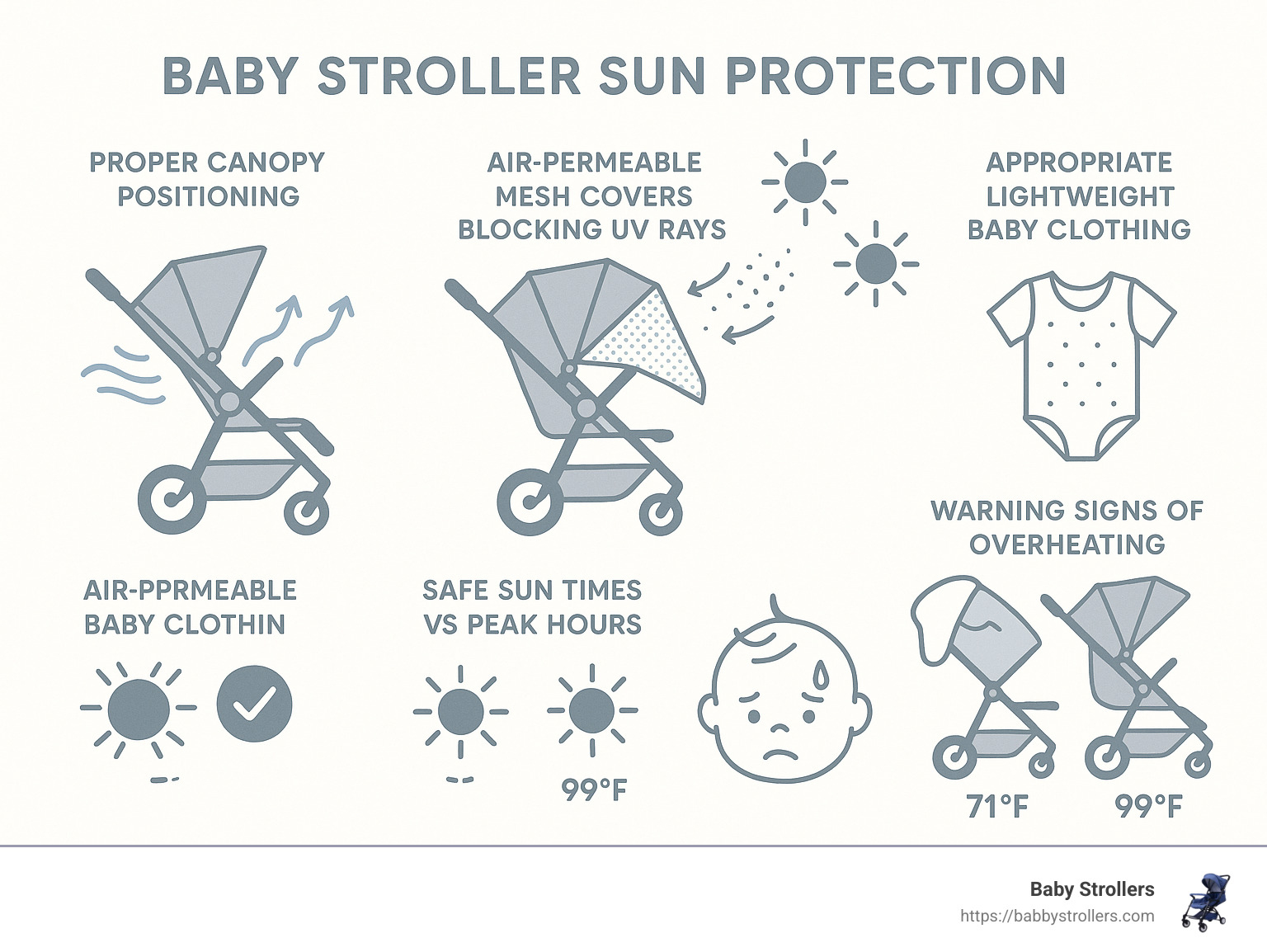
Understanding the Risks of Sun Exposure for Babies
Those tiny cheeks and delicate skin aren’t just adorable – they’re incredibly vulnerable to the sun’s harsh effects. A baby’s skin is fundamentally different from adult skin in ways that make sun protection absolutely essential when you’re figuring out how to protect baby from sun in stroller outings.
Baby skin is noticeably thinner and produces significantly less melanin – that’s the natural pigment that gives some protection against harmful UV rays. This difference isn’t minor; it makes your little one much more susceptible to sun damage than you might realize.
“A baby’s skin is not fully developed until they are about three years old,” explains Dr. Sarah Adams, pediatrician. “This means their skin barrier function is weaker, allowing UV rays to penetrate more deeply and cause more damage than in adults.”
When your baby is exposed to direct sunlight without proper protection, several serious risks come into play. An immediate sunburn can happen surprisingly quickly – sometimes in as little as 10-15 minutes – causing painful redness, swelling, and even blistering in severe cases. What’s particularly concerning is that this damage isn’t just temporary.
The statistics are truly sobering: research shows that suffering just one severe sunburn in childhood doubles the risk of developing melanoma later in life. For babies, whose skin is even more vulnerable than older children’s, these risks are significantly magnified. According to the American Academy of Pediatrics, babies under 6 months should be kept out of direct sunlight altogether because their skin contains too little melanin.
Dehydration and heat exhaustion represent another serious danger. Babies don’t sweat normally like adults do, which makes them less effective at cooling their bodies. This physiological difference means they can overheat much faster than you might expect, even when it doesn’t seem that hot to you.
What many parents don’t realize is the complex nature of heat-related risks. Surprisingly, humidity accounts for 70% of heat stroke risk, UV rays contribute 20%, and temperature only 10%. This explains why proper ventilation is just as crucial as shade when keeping your baby safe in a stroller.
Beyond the immediate risks, early sun exposure contributes to long-term skin damage, including premature aging and increased skin cancer risk. Your baby’s eyes are also more susceptible to UV damage, which can potentially affect vision development.
How to protect baby from sun in stroller outings isn’t just about preventing a little redness – it’s about safeguarding your child’s health now and for decades to come. With the right approach to sun protection, you can enjoy outdoor time while keeping those precious little ones safe from harm.
How to Protect Baby from Sun in Stroller: Top Tips for Sun Safety
Choose a Stroller with a Large Canopy
Your stroller’s canopy is your first defense against those harsh sun rays beating down on your little one. When shopping for a stroller, don’t underestimate the importance of a good canopy – it’s not just an accessory, it’s essential protection!
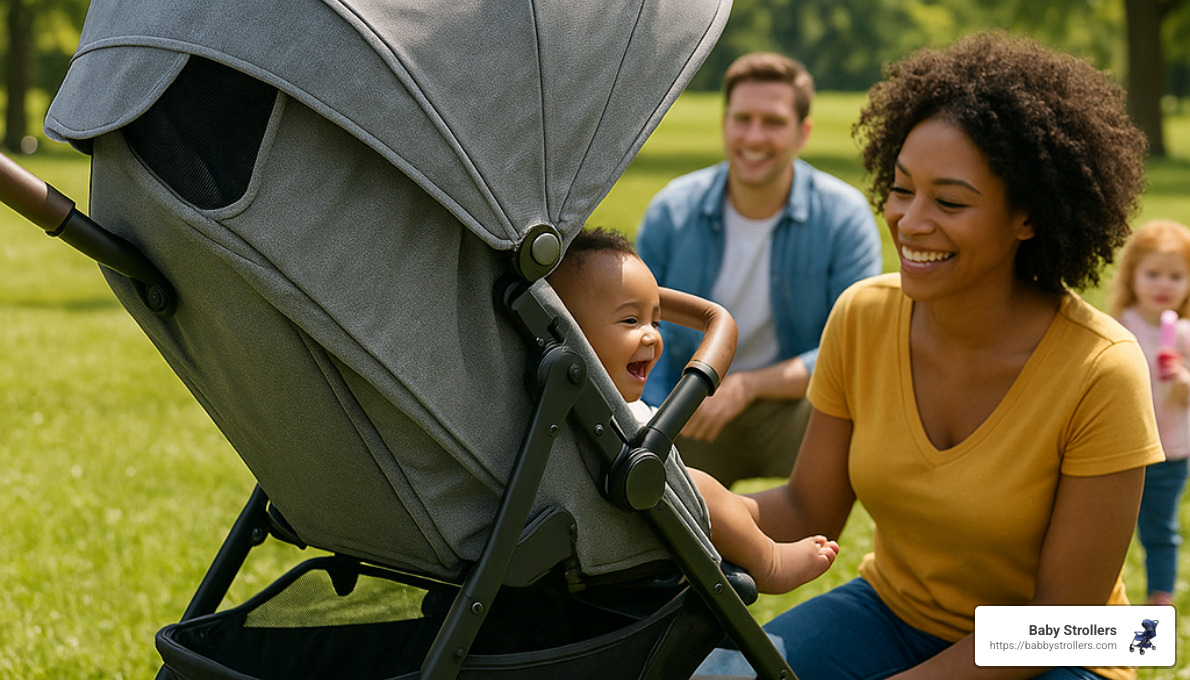
I always tell parents to look for UPF 50+ rated fabrics in canopies, which block at least 98% of harmful UV rays. An extendable design is worth its weight in gold because you can adjust the coverage as the sun moves throughout your walk. Those little peek-a-boo windows aren’t just cute – they let you check on your sleeping angel without disrupting their shade cocoon. And don’t forget about ventilation panels – those mesh sections allow for crucial airflow while keeping the sun at bay.
“I originally thought any canopy would do, but after our first summer outing left my daughter with pink cheeks, I upgraded to a stroller with an extendable UPF canopy. Best decision ever!” shared Maya, a mom from Arizona.
Many modern strollers now feature canopies that extend almost to the bumper bar, creating a cozy, sun-free zone for your baby. While this might cost a bit more upfront, the protection is priceless for your baby’s delicate skin. You can find plenty of options with excellent sun protection at BabbyStrollers.com.
Remember though, even the best canopy can’t always account for the changing angle of the sun, which is why we often need to add another layer of protection.
Use a Sunshade or UV-Protective Cover
When the built-in canopy just isn’t cutting it, a specialized UV-protective cover can be your sunshine superhero. But not all covers are created equal – the magic words you’re looking for are “air-permeable mesh.”
This is different from “breathable” fabrics (which typically just wick away moisture). Air-permeable mesh actually allows air to flow through the material while still blocking those nasty UV rays. This distinction is crucial because proper airflow prevents the dangerous heat buildup that can happen in enclosed spaces.
“My sister gave me a universal sun cover that was technically ‘breathable,’ but my baby would come out sweating. Once I switched to an air-permeable mesh cover, he was comfortable and protected – total game-changer!” explains Tricia, a first-time mom.
The best sun covers offer UPF 50+ protection while maintaining excellent ventilation. Look for covers with visibility windows so your curious little one can still see the world (and you can peek in). Most quality covers are designed with universal fit features to adapt to different stroller models and should be easy to install – because we all know wrestling with baby gear is the last thing you need during an outing!
Through our testing at BabbyStrollers.com, we’ve found that ideal sun covers block between 80-99% of UV rays while keeping air flowing freely. You can find our recommendations for the Best Buggy Sun Shade on our website.
Avoid Covering the Stroller with a Blanket
I cannot stress this enough – please, never cover your stroller with a blanket, towel, or regular fabric, even if it’s a lightweight muslin or seems “breathable.” This well-intentioned mistake can create dangerous conditions for your baby in minutes.
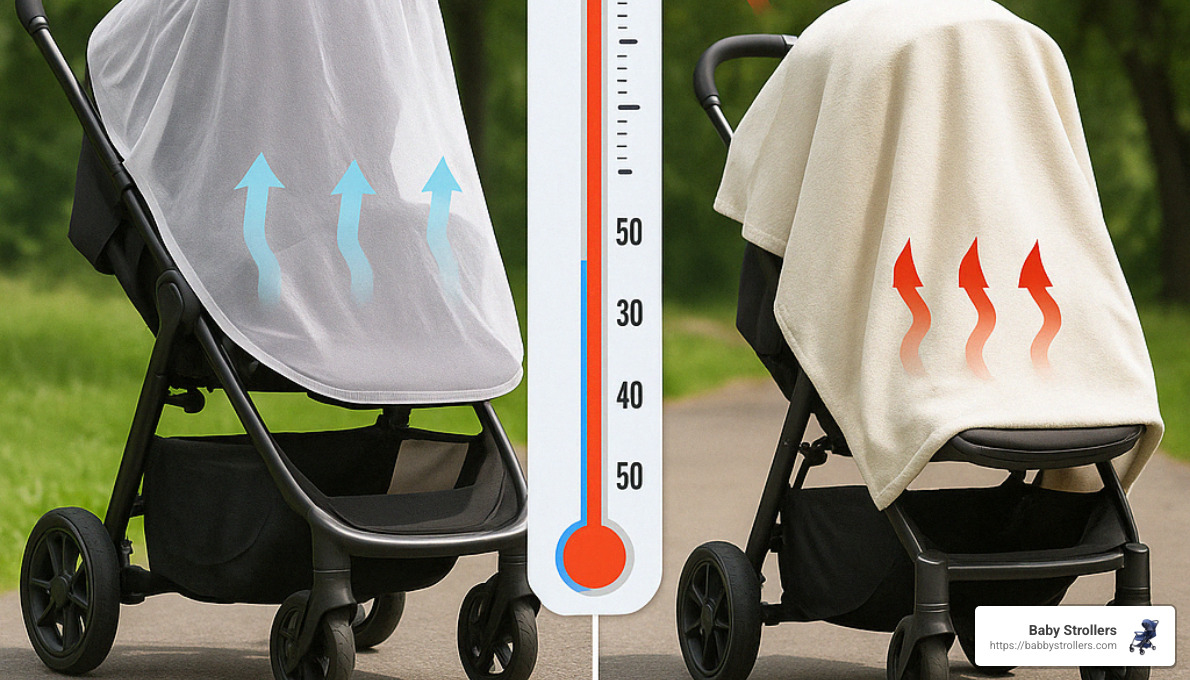
Swedish pediatrician Svante Norgren’s research revealed startling results that every parent should know. “It gets extremely hot down in the pram, something like a thermos,” he explains. His tests showed that while an uncovered stroller in the sun reached about 71°F, a stroller with just a thin cloth covering reached a dangerous 93°F after only 30 minutes and climbed to nearly 99°F after an hour.
When you drape a blanket over a stroller, you’re unintentionally creating a greenhouse effect that traps heat inside. You’re also restricting vital airflow that babies need for temperature regulation and increasing humidity – which actually contributes more to heat stroke risk than temperature alone. Perhaps most alarming is the potential suffocation hazard if the blanket were to fall onto your baby’s face.
“I used to think I was doing the right thing by covering my son’s stroller with a light blanket on sunny days,” admits Carlos, a dad of two. “After learning about the dangers, I immediately invested in a proper sun cover with mesh panels. The peace of mind is worth every penny.”
Instead of improvising with household items, invest in purpose-designed sun covers that strike that perfect balance between UV protection and proper ventilation. Your baby’s comfort and safety are worth it!
Ensuring Proper Ventilation and Preventing Overheating
When it comes to stroller safety, proper airflow is just as crucial as shielding your little one from the sun. Babies haven’t developed the same temperature regulation systems we adults have, which puts them at greater risk for overheating.
I always remind parents at our BabbyStrollers.com consultations that babies don’t sweat like we do. As Dr. Yallapragada from Children’s Medical Center explains, “Babies do not sweat normally, making them less effective at cooling their bodies compared to adults.” This simple biological fact means that what feels comfortable to you might actually be dangerously warm for your baby.
Most parents are surprised to learn that heat stroke isn’t primarily caused by temperature alone. The real culprits break down like this: humidity accounts for a whopping 70% of the risk, UV rays contribute 20%, and actual temperature only 10%. This means good ventilation to reduce humidity around your baby is even more important than shade!
To keep your baby comfortable and safe, make it a habit to check them frequently for overheating signs. I always tell new parents to touch the back of their baby’s neck rather than hands or feet, as extremities aren’t reliable temperature indicators. Also, create good air circulation around the stroller, position it strategically to catch gentle breezes while maintaining shade, and never leave the stroller parked in direct sunlight – even for what seems like just a minute or two.

Use Strollers with Mesh Panels or Ventilation Features
Modern strollers have come a long way in addressing both sun protection and ventilation needs. At BabbyStrollers.com, we’ve seen a wonderful evolution in design that prioritizes airflow without compromising on sun safety.
When I’m helping families choose their ideal stroller, I always point out key ventilation features to look for. Mesh panels in the canopy or seat back allow for continuous airflow while still providing shade. Adjustable back panels that can be unzipped or rolled up create instant ventilation when needed. Breathable seat fabrics prevent that sweaty-back syndrome babies often experience, and adjustable footrests create space for air to circulate underneath your little one.
“When selecting a stroller, look beyond just the canopy size,” I often advise parents during consultations. “The ventilation features are equally important, especially if you live in a humid climate or plan to use the stroller year-round.”
Some of our most popular models at BabbyStrollers.com feature clever ventilation systems with zip-down panels revealing mesh windows. These allow you to customize airflow based on the weather without sacrificing sun protection. It’s like having climate control for your baby!
If you’re working with a stroller that doesn’t have built-in ventilation features, don’t worry. There are great accessories that can help. Clip-on stroller fans create a gentle breeze, and air-permeable sun covers provide both protection and ventilation. The scientific research on overheating in strollers confirms that these simple additions can make a significant difference in keeping your baby’s environment safe.
The goal is to create a comfortable microclimate for your baby – protected from harmful UV rays while still enjoying fresh air circulation. With the right stroller features and accessories, you can enjoy outdoor trips with confidence, knowing your little one is both cool and protected.
Dressing Your Baby for Sun Safety in the Stroller
Choosing the right clothing for your little one is a crucial part of your sun protection strategy. Think of it as a wearable shield that works alongside your stroller’s sun-blocking features to keep your baby safe and comfortable during outdoor trips.
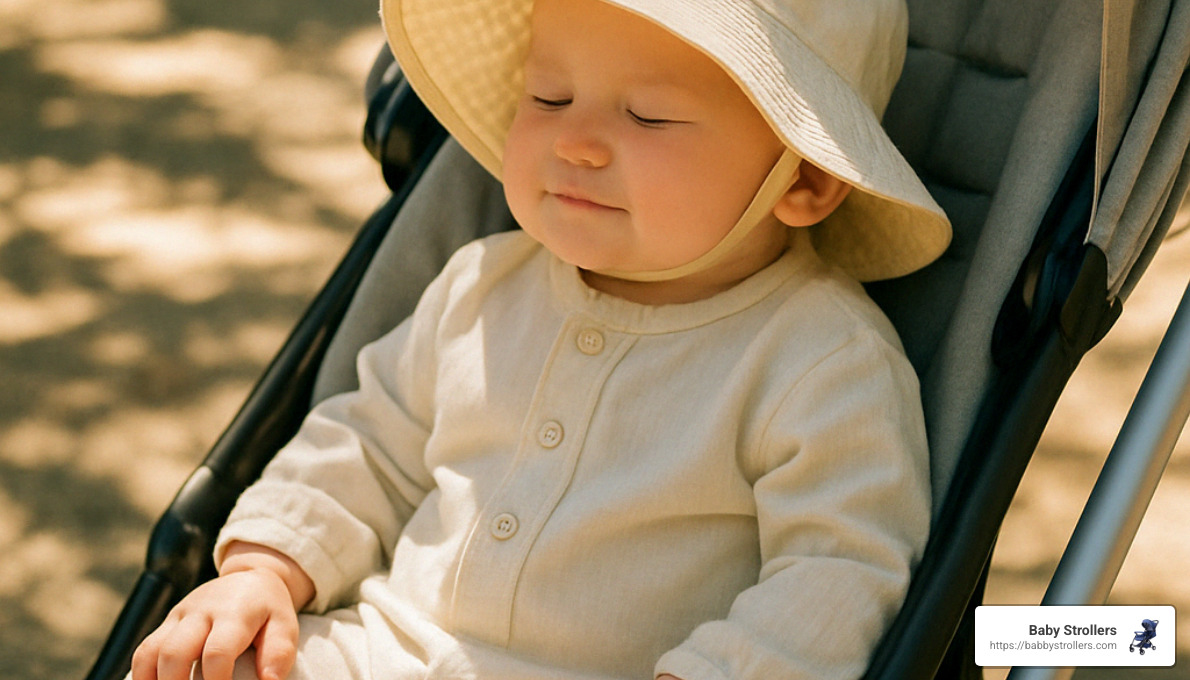
Opt for Lightweight, Breathable Fabrics
When it comes to dressing babies for sun protection, many parents make the mistake of thinking less clothing equals cooler babies. Actually, the opposite is often true! Lightweight cotton, bamboo, or linen fabrics create a physical barrier against UV rays while still allowing your baby’s skin to breathe.
“I used to dress my daughter in shorts and tank tops for summer strolls, thinking it would keep her cooler,” shares Monica, a mom from Arizona. “But my pediatrician explained that loose-fitting, long-sleeved clothing actually provides better protection and comfort. The lightweight cotton outfits we use now keep her much happier during our morning walks.”
For babies under 6 months (who shouldn’t wear sunscreen), protective clothing becomes even more important. Light colors reflect heat rather than absorbing it, keeping your little one cooler while still blocking harmful rays. And if you’re shopping specifically for sun protection, look for garments with a UPF rating – these special fabrics are designed to block UV rays more effectively than regular clothing.
How to protect baby from sun in stroller starts with what they’re wearing before they even get into the stroller. A good rule of thumb: if you can see light through a fabric when you hold it up, UV rays can penetrate it too.
Use Sun Hats and Sunglasses
A quality sun hat isn’t just an adorable accessory – it’s essential protection for your baby’s delicate face, ears, and neck. At BabbyStrollers.com, we’ve seen the difference a good hat makes during outdoor trips.
The perfect baby sun hat should have a wide brim of at least 3 inches all the way around (not just in front). Look for hats with UPF 50+ ratings that block at least 98% of harmful rays. Since babies are notorious for removing hats, find one with an adjustable chin strap that keeps it secure while having a breakaway feature for safety.
“There’s just something about babies in sunglasses!” laughs Dr. Amelia Chen, pediatric ophthalmologist. But beyond the cuteness factor, baby sunglasses serve a critical health purpose. Your little one’s eyes are particularly vulnerable to UV damage, which can affect developing vision.
When selecting sunglasses for your baby’s stroller outings, prioritize 100% UV protection covering both UVA and UVB rays. Wrap-around styles prevent light from entering from the sides, while flexible, unbreakable frames ensure comfort and safety. An adjustable strap helps keep them in place – though expect some resistance at first!
“My son hated sunglasses initially,” admits Tyler, father of a 10-month-old. “But we introduced them during indoor playtime first, making it a game. Now he reaches for them before we head out in the stroller. Consistency is key.”
By combining protective clothing with your stroller’s sun features, you’re creating multiple layers of protection against harmful UV exposure. How to protect baby from sun in stroller is about balancing protection with comfort – lightweight, full-coverage clothing does both beautifully.
Safe Use of Sunscreen on Babies
When it comes to how to protect baby from sun in stroller, sunscreen might seem like an obvious solution – but it’s not quite that simple with little ones. Their delicate skin requires special consideration, and knowing when (and when not) to use sunscreen is crucial for their safety.
When and How to Use Sunscreen on Babies
Here’s something many new parents don’t realize: sunscreen isn’t recommended for babies under 6 months old. Their skin is simply too sensitive and can absorb the chemicals more readily than older babies. The American Academy of Pediatrics and Skin Cancer Foundation are crystal clear on this – for these tiny babies, protection should come from shade, clothing, and limiting sun exposure instead.
Once your little one reaches the 6-month milestone, you can begin introducing sunscreen, but only on exposed areas that clothing doesn’t cover. I remember the first time I applied sunscreen to my daughter’s chubby little cheeks – I was so nervous about doing it right!
Timing matters when applying sunscreen. Slather it on 15-30 minutes before heading outside to give it time to work its magic. And don’t be stingy! Most parents (myself included, initially) don’t use enough product. For a baby, you’ll need proportionally less than an adult’s shot-glass-sized amount, but still be generous with coverage.
Those easily forgotten spots need extra attention – the tops of tiny ears, pudgy feet, and the back of the neck are sunburn magnets. And remember to reapply every two hours, or immediately after water play or excessive drooling (which, let’s be honest, is pretty much constant with babies).
One mom shared with us: “I only put sunscreen on the parts that will actually see sun, and I make sure to wash it all off the moment we get home. It gives me peace of mind about balancing protection with limiting chemical exposure.”
Choosing Baby-Safe Sunscreen
Not all sunscreens are created equal, especially when it comes to baby-safe options. Mineral-based formulas are the gold standard for babies, containing active ingredients like zinc oxide and titanium dioxide. Unlike chemical sunscreens that absorb into the skin, these create a physical barrier that sits on top of the skin.
“Think of mineral sunscreens as tiny shields reflecting UV rays away from your baby’s delicate skin,” explains Dr. Lauren Thompson, pediatric dermatologist. “They’re less likely to cause irritation and better suited for sensitive baby skin.”
When browsing the overwhelming sunscreen aisle, look for products labeled broad-spectrum (protecting against both UVA and UVB rays) with SPF 30 or higher. Water-resistant formulations are helpful too, especially if your baby is a drooler or you’ll be near water.
Many parents find sunscreen sticks particularly handy for facial application. They offer better control and precision, reducing the chance of sunscreen finding its way into curious eyes or mouths. If sunscreen does get into your baby’s eyes, gently wipe with a damp cloth to soothe the irritation.
Even the best sunscreen is just one piece of your sun protection strategy. At BabbyStrollers.com, we recommend a comprehensive approach that combines appropriate clothing, quality shade from a good stroller canopy, timing your outings wisely, and using sunscreen as your final defense against those persistent rays that find their way to your baby’s skin.
Additional Accessories to Keep Baby Cool and Protected
When it comes to how to protect baby from sun in stroller, the right accessories can make all the difference between a pleasant outing and a stressful one. Beyond the basics we’ve already covered, several clever add-ons can significantly improve your baby’s comfort and safety during sunny strolls.
Use a Stroller Fan for Air Circulation
A small, portable fan might seem like a simple addition, but it can be absolutely transformative on hot days. Good air movement helps whisk away the warm, humid air that can build up around your baby, even in a well-ventilated stroller.
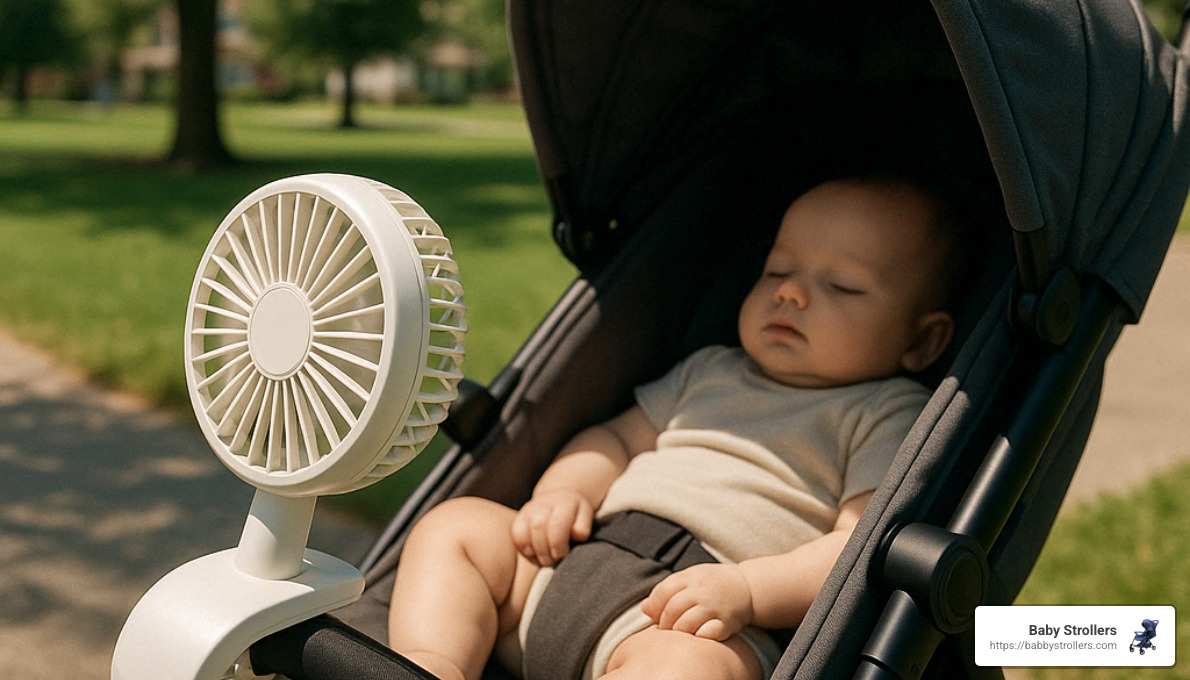
“I was skeptical about stroller fans at first,” admits Sarah, a mom from Arizona, “but ours has been worth its weight in gold. My daughter actually gets excited when I clip it on because she knows she’ll be comfortable during our morning walks.”
When shopping for a stroller fan, battery life is crucial—nobody wants a fan that dies halfway through an outing. We recommend rechargeable models that can last through several walks. Look for fans with flexible, adjustable arms so you can position the airflow exactly where your baby needs it most.
Safety is paramount, of course. The best stroller fans feature soft, enclosed blades that won’t harm curious little fingers. Many parents at BabbyStrollers.com tell us they prefer models with multiple speed settings and quiet motors that won’t disturb nap time.
“Position the fan to create a gentle breeze across your baby’s face rather than blowing directly on them,” suggests our stroller expert. “This mimics natural airflow and feels most comfortable.”
Employ Cooling Seat Pads
The contact point between your baby and the stroller can become surprisingly hot, especially with dark-colored stroller fabrics that absorb heat. Cooling seat pads address this problem directly by creating a more comfortable sitting surface.
Gel-filled cooling pads have become increasingly popular among our customers. These can be refrigerated before use and maintain their cooling effect for hours. They’re particularly helpful during afternoon outings when temperatures peak.
“My little one used to get so fussy in her stroller until we tried a cooling liner,” shares Michael, father of a 9-month-old. “Now she’s happy to sit and enjoy the scenery much longer, which means more outdoor time for all of us.”
Breathable 3D mesh liners work differently but are equally effective. Rather than actively cooling, they create space for air to circulate between your baby and the stroller seat, preventing heat and moisture buildup. These are great for everyday use and don’t require any preparation.
For a natural approach, bamboo or other temperature-regulating fabric liners wick away moisture and stay cooler than synthetic materials. Many parents prefer these for their sustainability and chemical-free properties.
Some creative parents have shared their DIY cooling methods with us too. The “Cold Water Bottle Sandwich” involves freezing small water bottles, wrapping them in thin towels, and tucking them alongside (never directly against) your baby to create a gentle cooling effect. Just be sure to check frequently that the towel wrapping remains dry and the setup stays secure.
While these accessories can significantly improve comfort, they complement rather than replace good shade and ventilation. The best approach to how to protect baby from sun in stroller is always a thoughtful combination of strategies custom to your climate and your baby’s needs.
At BabbyStrollers.com, we can help you find the perfect combination of stroller and accessories to keep your little one cool, comfortable, and protected on all your trips together.
Recognizing Signs of Overheating and Dehydration
As parents, we’re always watching out for our little ones, especially during outdoor trips. Even with the best sun protection in place, babies can still become overheated or dehydrated surprisingly quickly. Their tiny bodies haven’t yet developed the efficient temperature regulation systems that adults have, making them particularly vulnerable to heat-related issues.
Signs Your Baby Might Be Overheating
When you’re out and about with your baby in the stroller, keep a watchful eye for these telltale signs of overheating:
A flushed, red face and chest is often the first visible sign that your baby is getting too warm. You might notice their cheeks becoming particularly rosy – not the cute kind of rosy, but an intense redness that signals their body is struggling with the heat.
“The back of the neck is the best place to check if your baby is overheating,” shares Dr. Maria Santos, pediatrician. “Many parents make the mistake of checking hands or feet, but these extremities can remain cool even when a baby’s core temperature is dangerously high.”
Your baby might also show rapid breathing or panting as their body tries to cool down. This is particularly concerning if accompanied by restlessness or unusual irritability. On the flip side, lethargy or unresponsiveness can indicate severe overheating that requires immediate attention.
One mom from our BabbyStrollers community recalls, “I was so focused on applying sunscreen and adjusting the stroller canopy that I almost missed how quickly my daughter was overheating. Her normally happy demeanor changed completely – she became fussy and her little chest was heaving. That’s when I realized we needed to find shade immediately.”
Pay attention if your baby is refusing to drink or showing decreased wet diapers, as these can indicate dehydration. In more severe cases, you might notice vomiting or an liftd heart rate.
How to Respond if Your Baby Overheats
If you spot signs that your baby is too hot, don’t panic – but do act quickly. Your prompt response can prevent a mild case of overheating from becoming something more serious.
First, move to a cooler, shaded area immediately. This might seem obvious, but in the moment of worry, some parents focus on other interventions before addressing the primary issue – the heat source itself.
Gently remove excess clothing to help your baby’s body release heat more effectively. A onesie or light layer is usually sufficient while you help them cool down. Offer fluids frequently – breast milk, formula, or water if your baby is over 6 months old – to replace lost moisture and help regulate their temperature.
A technique many parents find helpful is using a damp, lukewarm washcloth on the face, neck, and extremities. The cloth should be lukewarm, not cold – extremely cold temperatures against overheated skin can actually constrict blood vessels and make it harder for the body to release heat.
“When my son showed signs of overheating during our walk, I found a shady bench, removed his outer layer, and offered him some breast milk,” shares Tina, a BabbyStrollers customer. “I also had a small spray bottle of water that I misted lightly on his arms and legs, which seemed to help cool him down quickly.”
While most cases of mild overheating resolve quickly with these measures, it’s crucial to seek emergency medical care if your baby shows severe symptoms like extreme lethargy, refusal to drink, or confusion. According to the CDC’s research on children and heat, babies and young children are among the most vulnerable to heat-related illness, and their condition can deteriorate rapidly.
Prevention is always better than treatment when it comes to how to protect baby from sun in stroller situations. Regular checks on your baby’s comfort, proper ventilation, appropriate clothing, and timing your outings to avoid peak heat hours are all key strategies for keeping your little one safe and comfortable during sunny trips.
Best Times to Take Your Baby Outside
Timing is everything when it comes to stroller outings with your little one. The right scheduling can make all the difference between a pleasant trip and an uncomfortable experience for both of you.
Schedule Outings During Cooler Parts of the Day
The sun doesn’t play fair between 10 AM and 4 PM. During these peak hours, UV rays are at their strongest and most harmful to your baby’s delicate skin.
For the safest and most comfortable stroller trips, aim for early morning walks before 10 AM. The world is quieter, temperatures are gentler, and the sun hasn’t yet reached its full strength. Many parents find that morning walks fit perfectly after breakfast, creating a lovely routine that babies come to enjoy.
“We’ve made our morning stroll part of our daily rhythm,” shares Maria, mom of 7-month-old Ellie. “We head out around 8 AM when the air still has that fresh feeling. Ellie seems more alert and interested in her surroundings, and I worry much less about sun protection.”
If mornings don’t work with your schedule, consider evening outings after 4 PM when the sun’s intensity begins to wane. The golden hour before sunset not only provides safer conditions for your baby but also offers beautiful lighting for those stroller photos you’ll treasure later.
Overcast days might seem perfect for outings, but clouds are tricky – they can block heat while still allowing up to 80% of harmful UV rays to reach your baby. On cloudy days, you’ll still need sun protection, but you might enjoy more comfortable temperatures.
For working parents with limited flexibility, even shifting your outdoor time by an hour earlier or later can significantly reduce your baby’s sun exposure while still enjoying fresh air together.
Check UV Index and Weather Forecasts
Before heading out with your baby, take a minute to check both the temperature forecast and the UV index. This simple habit can help you make smarter decisions about when to go out and how much protection your little one needs.
The UV index works like a warning system for your skin, telling you how quickly sunburn might occur:
Low (0-2): Generally safe for short outings with basic protection
Moderate (3-5): Take precautions like hats and shade
High (6-7): Serious protection needed; minimize midday exposure
Very High (8-10): Consider rescheduling or maximizing all protection
Extreme (11+): Best to stay indoors during peak hours
Most weather apps now include the UV index alongside temperature forecasts, making it easy to check before heading out. Some even send alerts when UV levels reach dangerous heights in your area.
“I never realized how helpful the UV index could be until I had my baby,” explains one dad. “Now it’s the first thing I check before planning our walks. On days when it’s 8 or above, we either stay home during peak hours or make sure we have every protection possible in place.”
Planning around the weather might require some flexibility, but the payoff is worth it—a happier, more comfortable baby and significantly reduced sun exposure. At BabbyStrollers.com, we recommend making this quick check part of your pre-outing routine, just as natural as grabbing your diaper bag or filling a water bottle.
Even on days when outdoor time seems impossible due to high UV levels, early mornings and evenings can still offer beautiful, safe opportunities for fresh air and a change of scenery for both you and your baby.
Frequently Asked Questions about Protecting Baby from Sun in Stroller
Is it safe to use sunscreen on babies under 6 months old?
When it comes to sunscreen and tiny babies, the American Academy of Pediatrics gives a pretty clear answer: it’s best to avoid it whenever possible for babies under 6 months. Their delicate skin isn’t just cute—it’s also highly absorbent, which means those sunscreen chemicals can penetrate more deeply and potentially cause irritation or reactions.
Instead of reaching for the sunscreen tube, protect your little sunshine by keeping them in the shade of a good stroller canopy, dressing them in lightweight but covering clothes, and planning your walks for morning or evening hours when the sun isn’t at its strongest. These approaches give you the best protection without introducing chemicals to your baby’s sensitive skin.
“I was so worried about sunburn that I almost used sunscreen on my 4-month-old,” shares Maria, a first-time mom. “My pediatrician explained that keeping her in the shade of her stroller with the proper cover was actually safer than applying sunscreen.”
If you absolutely cannot avoid sun exposure and clothing doesn’t provide enough coverage, the AAP does say you can apply small amounts of mineral-based sunscreen (look for zinc oxide or titanium dioxide as active ingredients) to exposed areas like the face and hands. But this should be your backup plan, not your primary strategy.
How can I keep my baby hydrated during hot weather?
Babies can become dehydrated surprisingly quickly in hot weather, which makes proper hydration essential during sunny stroller outings. Your approach to hydration should match your baby’s age and feeding style.
For exclusively breastfed babies, the answer is simple but might mean more frequent nursing sessions. Your breast milk provides all the hydration they need, but they’ll likely want to feed more often on hot days. Formula-fed babies might similarly need more frequent bottles during hot weather.
Once your little one reaches the 6-month milestone and has started solids, you can offer small sips of water in addition to their regular milk. Before that age, plain water isn’t recommended as it can disrupt their delicate electrolyte balance.
I’ll never forget when my neighbor rushed her 9-month-old to the pediatrician during a heatwave, worried about dehydration. “The doctor taught me to watch for fewer wet diapers and darker urine,” she told me afterward. “Now I’m much more proactive about offering extra fluids on hot days.”
Always keep an eye out for warning signs of dehydration including fewer wet diapers than normal, dark yellow urine, dry mouth, sunken eyes, or unusual lethargy. If you notice these signs, seek medical advice promptly.
What type of clothing is best for sun protection in strollers?
When it comes to dressing your baby for sun protection in the stroller, more coverage is actually better, even on warm days. Lightweight long sleeves and pants provide a physical barrier against harmful UV rays while still keeping your little one comfortable.
Light colors are your friend here—they reflect heat rather than absorbing it like darker colors do. Natural fibers like cotton, bamboo, and linen allow air to circulate around your baby’s skin, helping with temperature regulation.
“I used to dress my daughter in cute little sundresses for summer stroller walks,” admits Jamie, a mom of two. “But after learning about sun protection, I switched to lightweight cotton pants and long-sleeved tops. She actually seems more comfortable, and I worry less about applying sunscreen to her wiggly little body!”
Look for loose-fitting clothes that promote airflow and prevent overheating. For maximum protection, consider investing in specially designed sun-protective clothing with a UPF 50+ rating, which blocks 98% or more of harmful UV rays. These fabrics are treated to provide superior protection compared to regular clothing.
The right clothing creates an important layer of defense between your baby’s delicate skin and the sun’s harmful rays—making your stroller outings safer and more enjoyable for everyone. At BabbyStrollers.com, we recommend creating a sun protection outfit rotation that includes hats, lightweight long-sleeved options, and breathable pants to keep your baby protected from sun in the stroller without overheating.
Conclusion

As we’ve explored throughout this guide, how to protect baby from sun in stroller situations requires thoughtful attention to multiple factors. It’s a delicate balancing act, but one that becomes second nature with practice and the right equipment.
The sun’s rays might be invisible, but their effects on your baby’s delicate skin are very real. By implementing the strategies we’ve discussed, you’re not just preventing a painful sunburn today—you’re helping to protect your little one’s long-term health.
The most effective sun protection comes from a layered approach. Your stroller’s canopy provides the first line of defense, but it works best when complemented by proper clothing, strategic timing, and careful monitoring. Those UPF-rated air-permeable covers might seem like a small investment, but they can make a world of difference on sunny days.
I’ve seen parents transform their approach to outdoor time after learning about the dangers of covering strollers with blankets. That simple change—switching from a regular blanket to a proper mesh cover—can prevent the dangerous greenhouse effect that causes temperatures to soar inside the stroller.
Watching for signs of overheating becomes instinctual with time. You’ll find yourself automatically reaching for the back of your baby’s neck during stroller walks, or adjusting their clothing as the temperature changes throughout your outing.
At BabbyStrollers.com, we’re passionate about helping families enjoy outdoor trips safely. Our collection includes strollers designed with both sun protection and ventilation in mind, because we understand that these features aren’t just nice-to-haves—they’re essential for your baby’s wellbeing.
The joy of introducing your little one to the wonders of the outside world shouldn’t be overshadowed by concerns about sun damage. With the right equipment and knowledge, your stroller outings can be both safe and delightful for everyone involved. The sound of your baby’s happy babbling as you stroll through the park on a beautiful day is one of parenthood’s simple pleasures—one that’s well worth protecting with proper sun safety measures.
For more guidance on selecting the perfect stroller for your family’s unique needs, browse our comprehensive buying guides or reach out to our friendly team. We’re here to help you steer strollers with confidence, ensuring your outdoor trips are as safe as they are memorable.

